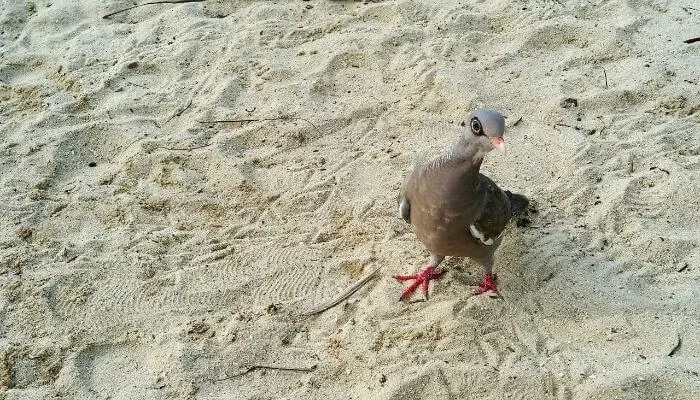If you’ve spotted a pigeon with a peculiar look around its eyes before, you’ve probably spotted a Bare-eyed pigeon.

Those pigeons are common in South America, and they can often be mistaken for White-winged doves. However, several differences set them apart.
Let’s dive into more details about the Bare-eyed pigeon so that it’s easier for you to identify it.
Bare Eyed Pigeon Origins
Bare-eye pigeons originate in South America and aren’t widely spread worldwide.
You can spot them on Colombia’s and Venezuela’s Caribbean shores.
During the breeding season, they can also be sighted around the shores of Aruba and Curaçao.
- Order: Columbiformes
- Family: Columbidae
- Genus: Patagioenas
The Bare-eyed pigeons belong to the Columbidae family.

Doves are members of this family as well.
In fact, there are around 344 recorded species in this family.
However, 13 of said species have become extinct as a result of hunting and climate change.
The Bare-eyed pigeons’ genus is Patagioenas. Birds in this genus are divided into four groups based on their appearances.
The Bare-eyed pigeon belongs to the Leucocephala category. The dark plumage of this group, as well as the white rims of their wings, help to identify them.
Habitat
Bare-eyed pigeons like subtropical and tropical dry woods.
They’re also fond of dry shrubland.
They’ve been seen as high as 1,312 feet on occasion.
Some of these birds have become accustomed to the development of society.
As a result, they eat on farmland and in city environments regularly.
Conservation Status
These birds’ population was notably low until around two decades ago.
The population appears to be growing now, though.

As a result, the pigeons don’t appear to be on the verge of extinction anymore.
However, they’re still regularly hunted.
Behavior
The behavior of the Bare-eyed pigeon hasn’t been well documented.
However, they’re believed to be excellent flyers.
They’re regularly seen flying over water bodies.
Diet
Bare-eyed pigeons scavenge primarily in trees and bushes, but they’ll occasionally eat on land.
Seeds and fruits of trees, as well as vegetation, make up its diet.
They can also eat human food, such as fries or popcorn, that is on the ground.
Breeding Bare Eyed Pigeons
There isn’t much recorded about the Bare-eyed pigeon’s breeding cycle.
However, it’s believed that it’s initiated by rain.
They go around and try to find suitable sticks and twigs usually found in trees or bushes.
They then use these sticks to build their nest on top of a tree.
Since the Bare-eyed pigeon uses fragile twigs, the eggs can often be seen from the ground.
So if a bird is flying high or if you walk underneath the tree, the eggs will be so easily observed.
It takes around 17 days for an egg to hatch.
Then, the mother takes care of the baby birds until they’re able to fly.
It usually takes around 14 days after hatching for the young pigeon to fly.
Appearance Of The Bare Eyed Pigeon
The Bare-eyed pigeons have some unique appearance qualities.

These qualities make them stand out from other pigeons.
| Wingspan | Length | Weight | Coloring | |
|---|---|---|---|---|
| The Bare-Eyed Pigeon | Not Documented | 32-37 cm Males 30-34.5 cm Females | 274g | Pale bluish gray with some pale brown/black and a black ring around their eyes. |
| Average Feral Pigeon | 64 – 72 cm | 32 – 37 cm | 300 – 500g | Bluish gray with some black |
The ring around the eye of the pigeon is its most distinguishing characteristic.
They make the eye look like a bullseye.
Some other breeds of pigeons, such as Speckled Pigeons, have similar rings around their eyes.
However, what differentiates them from other pigeons is that the ring is dark and has exposed skin.
The Bare-eyed pigeons have white streaks on both wings.
Those streaks are most evident in flight but can also be seen in other postures.
Their primary wing feathers are dark.
These birds’ neck plumes can also be somewhat glossy, which is why they tend to flare when the sun shines right on them.
Both sexes have the same appearance:
- They have a pink head and a bluish-gray crown.
- Their body is a faint bluish gray.
- Their feet are pastel pink.
- Their bills are also pink. However, the shade is much lighter than that of their feet.
Young Bare-eyed pigeons are similar in appearance.
They do not, however, have the dark ring around their eyes.
Their heads and necks are browner, and their bills are more rose in color.
Similar Birds
Bare-eyed pigeons can be easily confused with White-winged doves, which are native to North America and the Caribbean.
Like the Bare-eyed pigeons, they usually reside in desert environments.
So if you live in a state like Texas or Arizona, you’re more likely to find those beautiful doves.
White-winged doves and Bare-eyed pigeons have similar feather patterns.
However, the dove is smaller and has a different form.
For example, both have rings around their eyes, but the White-winged dove’s rings are a light blue.
They also aren’t as easily visible as Bare-eyed pigeons.
The white tips on the tail help to identify the White-winged dove.
This dove also sports a dark bill and a grayish-brown upper body.
Summary
There are a lot of amazing-looking pigeons flying around us.
Few, however, compares to the Bare-eyed pigeon’s distinct appearance.
You can often find them in desert habitats.
Even though they were once considered endangered, their numbers are presently stable.
As a result, you’ll see a lot more of these birds soaring around.
If you come across one, make sure to photograph it!
